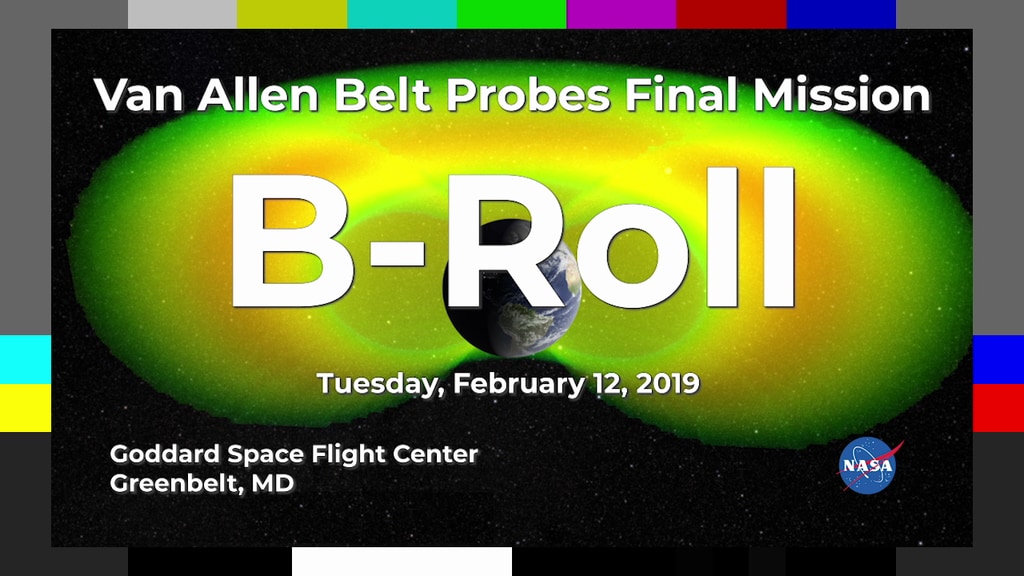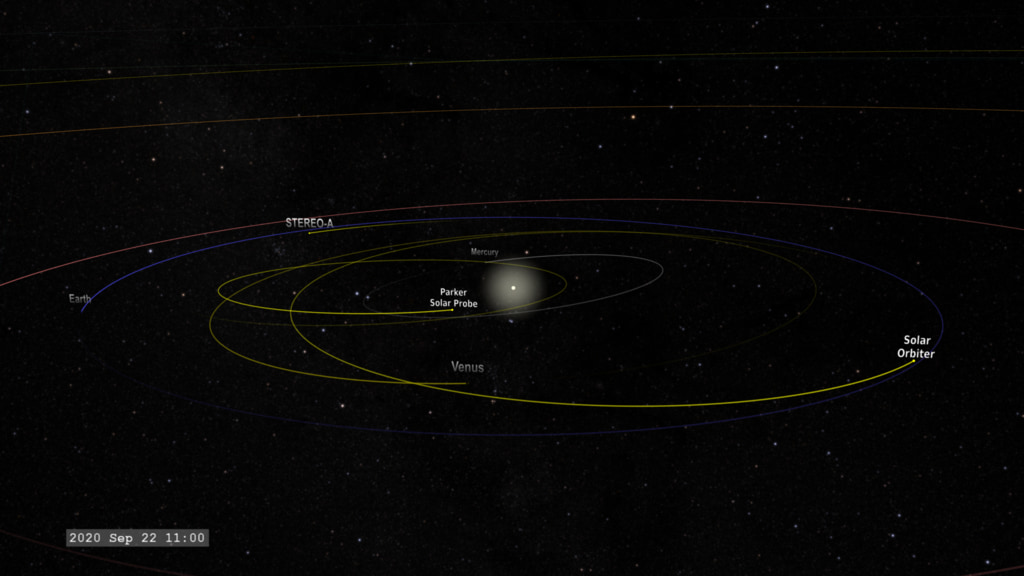Heliophysics Sentinels 2020 (Forecast Version)
In addition to the NASA missions used in research for space weather (see 2020 Heliophysics Fleet) there are additional missions operated by NOAA used for space weather forecasting. As of spring 2020, here's a tour of the NASA and NOAA Heliophysics fleets from the near-Earth satellites out to the inner solar system.
The satellite orbits are color coded for their observing program:
Magenta: TIM (Thermosphere, Ionosphere, Mesosphere) observations Yellow: solar observations and imagery Cyan: Geospace and magnetosphere Violet: Heliospheric observations
This visualization presents orbits of the current heliophysics satellites covering the space near Earth, out to the Sun-Earth Lagrange point, L1, and finally a view of the current missions operating in the inner solar system.
Near-Earth Fleet:
- Hinode: Observes the Sun in multiple wavelengths up to x-rays. SVS page
- TIMED: Studies the upper layers (40-110 miles up) of Earth's atmosphere. SVS page
- ICON: Works with GOLD on studies of the ionosphere.
- AIM: Images and measures noctilucent clouds. SVS page
- IRIS: Interface Region Imaging Spectrograph is designed to take high-resolution spectra and images of the region between the solar photosphere and solar atmosphere. SVS page
- SET: Space Environment Testbed exploring radiation-hardening technologies
Geosynchronous Fleet:
- GOES East & GOES West: The GOES satellites provide continuous imagery of Earth's western hemisphere and monitor the solar X-ray flux.
- SDO: Solar Dynamics Observatory keeps the Sun under continuous observation at 16 megapixel resolution. SVS page
- GOLD: Global-scale Observations of the Limb and Disk is a spectroscopic imager for studying the ionosphere.
Geospace Fleet:
- Geotail: Conducts measurements of electrons and ions in the Earth's magnetotail. SVS page
- Magnetospheric Multi-scale (MMS): This is a group of four satellites which fly in formation to measure how particles and fields in the magnetosphere vary in space and time. SVS page
- THEMIS: This is a fleet of three satellites to study how magnetospheric instabilities produce substorms. Two of the original five satellites were moved into lunar orbit to become THEMIS-ARTEMIS.SVS page
- IBEX: The Interstellar Boundary Explorer measures the flux of neutral atoms from the heliopause. SVS page
Lunar Orbiting Fleet:
- THEMIS-ARTEMIS: Two of the THEMIS satellites were moved into lunar orbit to study the interaction of the Earth's magnetosphere with the Moon. SVS page
Sun-Earth Lagrange Point One Fleet:
The L1 point is a Lagrange Point between the Sun and the Earth. Spacecraft can orbit this location for continuous coverage of the Sun.
- DSCOVR: Observes Earth and measures the solar wind.
- SOHO: Studies the Sun with cameras and a multitude of other instruments. SVS page
- ACE: Measures the composition and characteristics of the solar wind. SVS page
- Wind: Measures particle flows and fields in the solar wind. SVS page
Solar Orbiting Fleet:
- STEREO-A: The remaining STEREO spaceraft orbits the Sun in roughly the same orbit as Earth. SVS page
- Parker Solar Probe: On an orbit that takes it closer to the Sun than any other mission. SVS page
- Solar Orbiter: On an orbit that takes it to high solar latitudes. SVS page
For More Information
See NASA.gov
Credits
Please give credit for this item to:
NASA's Scientific Visualization Studio
-
Visualizer
- Tom Bridgman (Global Science and Technology, Inc.)
-
Technical support
- Laurence Schuler (ADNET Systems, Inc.)
- Ian Jones (ADNET Systems, Inc.)
Release date
This page was originally published on Monday, March 1, 2021.
This page was last updated on Thursday, January 25, 2024 at 12:13 AM EST.
Missions
This visualization is related to the following missions:- ACE
- Deep Space Climate Observatory (DSCOVR)
- Geotail
- Global-scale Observations of the Limb and Disk (GOLD)
- GOES-R
- Hinode (Solar-b)
- IBEX
- Ionospheric Connection Explorer (ICON)
- IRIS: Interface Region Imaging Spectrograph
- Magnetospheric Multiscale (MMS)
- Parker Solar Probe
- SDO
- SOHO
- Solar Orbiter Collaboration
- Space Environment Testbeds (SET)
- STEREO
- THEMIS
- THEMIS and ARTEMIS
- TIMED
- Voyager
- Wind
Series
This visualization can be found in the following series:Datasets used in this visualization
-
SSCweb ephemerides (SSCweb)
ID: 538Satellite ephemerides
This dataset can be found at: http://sscweb.gsfc.nasa.gov
See all pages that use this dataset -
Space-Track TLE (Space-Track Two-Line Elements)
ID: 753Satellite ephemerides
This dataset can be found at: http://Space-Track.org
See all pages that use this dataset -
DE 431
ID: 985Planetary ephemerides SPICE kernel
See all pages that use this dataset
Note: While we identify the data sets used in these visualizations, we do not store any further details, nor the data sets themselves on our site.
![Watch this video on the NASA Goddard YouTube channel.Complete transcript available.Music credits: “Boreal Moment” by Benoit Scarwell [SACEM]; “Sensory Questioning”, “Natural Time Cycles”, “Emerging Designer”, and “Experimental Design” by Laurent Dury [SACEM]; “Superluminal” by Lee Groves [PRS], Peter George Marett [PRS] from Killer Tracks](/vis/a010000/a013200/a013275/13275_AstronautRadiation_Twitter.01205_print.jpg)

